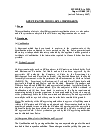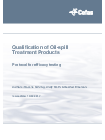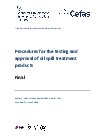Marine Management Organisation

Details
All oil spill treatment products must be tested for their efficacy (effectiveness) and for toxicological hazard. The tests can be carried out within MMO-commissioned laboratories, or by independent laboratories selected by you. Independent laboratories must follow standard test protocols and have a recognised accreditation for the toxicity test, efficacy test, or both.
Dispersant specifications and efficacy
Products are tested to make sure they meet the specifications in appendix A to WSL Report LR448.
This includes aspects of appearance, dynamic viscosity, flash point, cloud point, miscibility and efficiency. Efficacy is determined by a standard laboratory-based procedure described in annex 1 to appendix A WLS Report LR448. The efficacy test aims to assess the proportion of the total volume of treated oil that is dispersed into the water column.
The minimum efficacy requirements depend on the type of dispersant being tested.
Dispersants must achieve an efficact of 30% for type 1 (hydrocarbon solvent-based dispersant applied undiluted) and type 2 (concentrates diluted 1:10 with seawater before application) and 60% for type 3 (high efficacy concentrates applied undiluted).
Efficacy tests
| Type of test | Dispersant (inshore and offshore) | Dispersant (offshore only) | Sorbent | Bioremediation product | Degreaser |
|---|---|---|---|---|---|
| WSL LR 448 | Y | Y | N | N | N |
| Flask Test | N | N | N | Y | N |
| Microcosm Test | N | N | N | Y | N |
Toxicity to marine species
There are 2 toxicity tests.
The first test is called the Sea Test and is carried out using the brown shrimp (Crangon crangon). This test compares the relative toxicity of an oil dispersant mix to that of oil alone.
The second test is called the Rocky Shore Test and is carried out using the common limpet (Patella vulgate). This test compares the toxicity of dispersant alone to that of the standard test oil. Offshore dispersants are not required to pass the Rocky Shore Toxicity Test, but may only be used in waters more than 12 nautical miles from the baseline.
| Type of test | Dispersant (inshore and offshore) | Dispersant (offshore only) | Sorbent | Bioremediation product | Degreaser |
|---|---|---|---|---|---|
| Rocky Shore Test | Y | N | Y | Y | Y |
| Sea Test | Y | Y | Y | Y | Y |
| Agitation toxicity test 1 | N | N | N | Y | N |
| Agitation toxicity test 2 | N | N | N | Y | N |
| Wildlife licence | N | N | N | Y (if contains bacteria) | N |
See the Procedures for the approval of oil spill treatment products in the UK (PDF, 113KB) for more information which discusses the 3 types of oil treatment product for use at sea or on beaches, and the method to test the efficiency index of each dispersant before it can be used.
Bioremediation products are subject to 2 further toxicity tests, and it will also be necessary to obtain microbiological hazard data. A licence is needed to introduce a new plant or animal species. If your bioremediation product contains a bacterial component you may need to apply for a wildlife licence.



